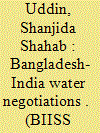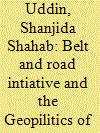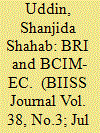|
|
|
Sort Order |
|
|
|
Items / Page
|
|
|
|
|
|
|
| Srl | Item |
| 1 |
ID:
159611


|
|
|
|
|
| Summary/Abstract |
Sharing river water between neighbours is a complicated task as it creates upstream-downstream supply disputes. Having the highest number of common rivers with its biggest neighbour – India, Bangladesh has to face common water sharing disputes with that country. To resolve disputes over water sharing, Bangladesh started negotiations with India after its independence, but the country has been facing challenges in reaching a consensus on a formula and mechanism to share the common water. Given this backdrop, the present paper argues that the water negotiations between Bangladesh and India are being affected due to significant negotiation challenges which make the water negotiations a zero-sum game. With this argument, the paper endeavours to examine the challenges of Bangladesh-India water negotiations. To understand these challenges, this paper evaluates historical fact, past and ongoing water negotiations between Bangladesh and India. Some possible solutions are also suggested in the paper to overcome these challenges.
|
|
|
|
|
|
|
|
|
|
|
|
|
|
|
|
| 2 |
ID:
170622


|
|
|
|
|
| Summary/Abstract |
This paper examines how China’s latest mega plan – the Belt and Road Initiative (BRI) will influence the geopolitics of energy. With a massive change in global energy supply and demand, the transition of international energy order is in the making. While the USA is going towards more isolationist path from its traditional superpower role, there are growing economies such as China, India, Japan and Russia which are undoubtedly playing important role on geopolitical stage. Several regions such as Central Asia, the Arctic, Eastern Mediterranean and South China Sea are offering huge natural gas and oil reserves and drawing global attention to develop energy cooperation. This situation is profoundly influencing the transition of energy order. In this transition, BRI is supposed to play an important role. As a mega development strategy with strong geostrategic dimension, it aims at promoting interconnectivity and cooperation in infrastructure, trade and development among the participating countries. This mega plan offers plenty of investments, infrastructure constructions and industrial integration in the energy sector. In addition, China is trying to build alternative energy shipping routes for evading heavy dependence on traditional energy chokepoints, specifically on the Strait of Malacca. In doing so, the country is trying to establish a multilateral platform for promoting and protecting energy cooperation under BRI. This paper, therefore, attempts to observe how this mega plan will contribute in re-shaping the existing energy order as well as the geopolitics of energy with a focus on multilateral energy cooperation.
|
|
|
|
|
|
|
|
|
|
|
|
|
|
|
|
| 3 |
ID:
161952


|
|
|
|
|
| Summary/Abstract |
The Belt and Road Initiative (BRI) is one of the largest development plans
initiated by China which includes 65 countries covering Asia, Africa and Europe.
While Bangladesh-China-India-Myanmar Economic Corridor (BCIM-EC) is a subregional cooperation that aims to introduce new impetus to economic and social
development by linking the southwestern parts of China with northeastern
region of India and the Bay of Bengal through Yangon and Mandalay in
Myanmar, and Bangladesh. Although BCIM-EC was initiated long before the
inception of BRI, China later incorporated it under BRI platform as one of the six
economic corridors. Instead of analysing why BCIM-EC was incorporated within
BRI, the paper attempts to focus on the impediments that BRI and BCIM-EC are
facing during implementation phase. Therefore, the paper limits its scope to
examine the impediments and investigate how China as a pioneer of BRI along
with member countries of both BRI and BCIM-EC can overcome these emerging
challenges. The paper attempts to formulate policy suggestions recommending
strategies for China to overcome these impediments with the assistance and
support of all the member countries of BRI and BCIM-EC.
|
|
|
|
|
|
|
|
|
|
|
|
|
|
|
|
|
|
|
|
|